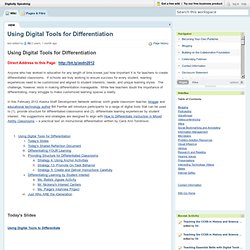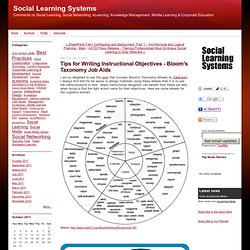

40 Open Education Resources You Should Know About. 50 Teaching and Lesson Plans that Rock 8/7/2012. Digital Differentiation. Technology is a tool that can be used to help teachers facilitate learning experiences that address the diverse learning needs of all students and help them develop 21st Century Skills.

At it's most basic level, digital tools can be used to help students find, understand and use information. When combined with student-driven learning experiences fueled by Essential Questions offering flexible learning paths, it can be the ticket to success. Here is a closer look at three components of effectively using technology as a tool for digital differentiation.
Note: The interactive graphics you see below have been updated. They can be found in a newer post on this blog. The goal is to design student-driven learning experiences that are fueled by standards-based Essential Questions and facilitated by digital tools to provide students with flexible learning paths. Essential Questions: Student-driven learning experiences should be driven by standards-based Essential Questions. Using Digital Tools for Differentiation. Direct Address to this Page: Anyone who has worked in education for any length of time knows just how important it is for teachers to create differentiated classrooms.

If schools are truly working to ensure success for every student, learning experiences need to be customized and aligned to student interests, needs, and unique learning styles. The challenge, however, rests in making differentiation manageable. While few teachers doubt the importance of differentiating, many struggle to make customized learning spaces a reality. In this February 2012 Alaska Staff Development Network webinar, sixth grade classroom teacher, blogger and educational technology author Bill Ferriter will introduce participants to a range of digital tools that can be used to (1). provide structure for differentiated classrooms and (2). differentiate learning experiences by student interest. Today's Slides Today's Shared Reflection Document To access our shared written reflection document, click here.
She writes: The Best Resources On Differentiating Instruction. My colleague Katie Hull-Sypnieski is leading a February 1st Education Week Webinar on differentiating instruction, and I would strongly encourage people to participate.

Katie’s the best teacher I’ve ever seen…. In addition, Katie and I have co-authored a piece for Education Week Teacher on the topic that will be appearing there soon (it’s appeared: The Five By Five Approach To Differentiation Success), and an upcoming post in my blog there will be talking about it, too (that two part series has also appeared). I also did a second two-part series in Ed Week on differentiation. Also, check out The Best “Fair Isn’t Equal” Visualizations. Given all that, a “The Best…” post was inevitable, and here it is.
Here are my choices for The Best Resources On Differentiating Instruction: The Best Places To Get The “Same” Text Written For Different “Levels” Busting Myths about Differentiated Instruction is by Rick Wormeli. Reconcilable Differences? Critical Thinking Skills. Tips for Writing Instructional Objectives - Bloom's Taxonomy Job Aids. I am so delighted to see this post that includes Bloom's Taxonomy Wheels by ZaidLearn.

I always find that it's far easier to design materials using these wheels than it is to see the verbs/products in lists. Many instructional designers can benefit from these job aids when trying to find the right action verbs for their objectives. Here are some wheels for the cognitive domain. Source: Source: Source: Bloom’s digital taxonomy. Have fun, designers!